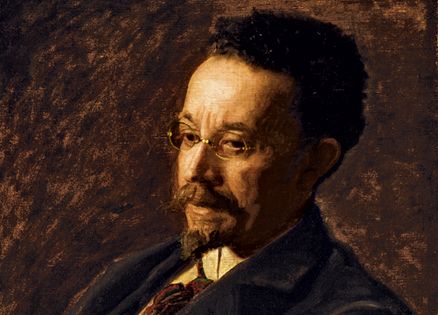What does an angel look like?
I was asking myself this question not long ago at an exhibit on turn-of-the-last-century painter Henry Ossawa Tanner at the Pennsylvania Academy of the Fine Arts (the stunning retrospective moves to Cincinnati Art Museum in May and the Museum of Fine Arts, Houston in October).
Tanner has always been a favorite of mine ever since I saw his painting of “The Annunciation.” There the angel Gabriel is simply a shaft of light, almost like something from Star Wars. It trembles before a realistically youthful Mary in the corner of a Galilean house, the bedclothes crumpled at her feet.
No pretty cherub with wings and a lily, this electric bolt gets an immediate response. You can see it in Mary’s expression, a combination of terror and awe. Why would God send his angel to her? Why was she of all women chosen?
It’s as though this brilliant messenger has just told her “Fear not,” and the message is slowly dawning on her.
Evidently Tanner used his own wife as a model for Mary, and here you get a glimpse of his own poignant story. She was white. He was black, his father a bishop in the AME church. His mother was a former slave who escaped through the Underground Railroad.
Born in Pittsburgh in 1859, Tanner spent the bulk of his career in France. He exhibited year after year at the Paris salon where he won prizes and international fame. Americans collected him and promoted his work.
But in that era he never would have prospered if he had stayed in his homeland. As he once observed, if he were walking in an American city with his blond-haired son, he’d be mistaken for the boy’s servant.
At first when he arrived in Paris in 1891, he did some black genre paintings, but most of his work is drawn from the Bible. That was a good professional choice. Biblical scenes were popular at the time, as the curator of the exhibit, Anna Marley, told me.
But there was nothing cynical about his approach. Tanner is that rare modern artist, both religious and spiritual, a mystic and realist.
Take his picture of Jesus appearing to Nicodemus on a Judean rooftop in the middle of the night. In an early sketch he drew a halo above Jesus’s head, but in the finished version, he shows the transforming power of Jesus with golden light illuminating his face and chest.
In the painting that first won Tanner fame, “The Resurrection of Lazarus,” he made sure that Jesus appears as a man who felt his followers’ pain. After all, this comes on the heels of that shortest-verse-of-the-Bible moment when “Jesus wept.”
Like his father the bishop and scholar, Tanner revisited Biblical passages to mine them for their meaning. One scene he painted again and again was Mary and Joseph’s flight into Egypt, the two escaping in blue-lit shadows through rough terrain.
Was this a reference to his own flight from his native country? Perhaps.
He painted Daniel in the lions den twice, a meditation on imprisonment and slavery. After all, Tanner was born before the Emancipation Proclamation and lived through the sorrow of the Jim Crow laws.
And yet there is always hope in a Tanner picture. One of my favorites, the last painting he ever did, in 1936, is “The Return from the Crucifixion.”
Mary and the disciple John’s face are shrouded in sorrow and misery, but the sky behind them is dazzling with purple, blue and gold. It is as though Tanner is saying, “Look up. The story isn’t finished yet. Something glorious is still ahead. Just wait. It’s going to happen soon.”
Tanner made many trips to the Holy Land to give verisimilitude to his work. He did countless sketches of clothes, buildings, landscapes, but the world his work inhabits is one of a mystical space beyond time and place.
When he painted Jesus walking on the water of Galilee, the water shimmers brighter than the heavens. If the disciples would only look to it they would see the beauty of the world rather than their fears.
When he painted the shepherds in their fields watching their flocks by night, he did it from the sky. He takes a viewpoint among the angels, looking through their diaphanous wings.
What does an angel look like? I found the most satisfying answer to that question in Tanner’s painting of the three Marys on Easter morning.
The wall of the city of Jerusalem is just barely visible in the background and the light of dawn is just appearing. The women are shocked and amazed. The heavy stone at the tomb has been rolled away, the body is no longer there. What has happened?
The angel says to them, “Fear not, for I know that ye seek Jesus which is crucified. He is not here for he is risen.” According to the Bible, this angel had a countenance “like lightning and his raiment white as snow.”
But Tanner doesn’t show the angel. What you know about him is the wonder and joy in the women’s faces, the radiant light illuminating their clothes and hands.
How do you see an angel? You see him in those whose lives have been changed forever when they met him and heard him say “Fear not.”
Tanner suffered through an era of terrible prejudice and bigotry. In one devastating example he told of being kicked off an American streetcar in a raging snowstorm because he and his mother were black. But he did not remain bitter.
What he finally had to communicate was the good news. Fear not. Look to the sky. There is hope. Easter has come.
Download your FREE ebook, True Inspirational Stories: 9 Real Life Stories of Hope & Faith





